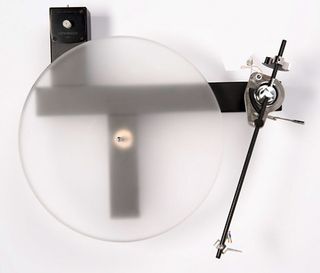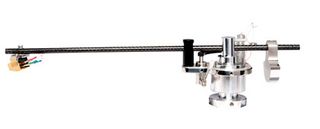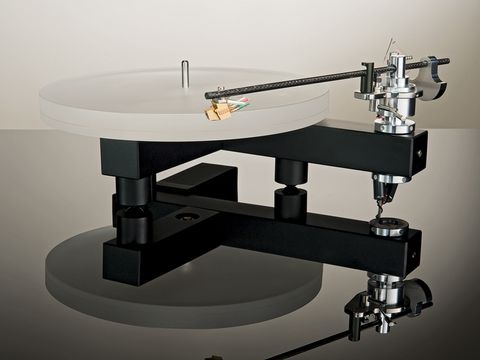TechRadar Verdict
A turntable combined with an effortless sounding tonearm, this is a top-flight pairing
Pros
- +
Combines fluidity with resolution to great musical effect
- +
Good acrylic platter
- +
Good speed accuracy
- +
No noticeable flutter
Cons
- -
Monstrously fiddly arm to set up, but you only have to do it once
Why you can trust TechRadar
The Consonance LP6.1/T988 is a radical piece of turntable design. In fact, rarely have we seen such a simple, skeletal approach to the ongoing challenge of mounting a platter, tonearm and motor.
The supplied T988 uni-pivot tonearm is, on the other hand, rather elaborate with a slim-line carbon- fibre main tube and fancy counterweight. Also unusual is the use of nylon filament as a drive belt, an approach derived from the use of fine silk on high-end turntables.
What's more, the novelty doesn't end there because Consonance has taken the unusual step of adding a foam mat to the acrylic platter. This combination marks the LP6.1 as one of the most distinctive designs at its price.
Good vibrations
One of the best established Chinese manufacturers, Consonance started way back in the post communist boom of the early nineties. Now it has a huge range of components and makes everything from CD players to horn speakers.
The LP6.1 is its least expensive turntable to date and a simpler design we have yet to see. The basis is a box-section aluminium T-bar that supports platter bearing and tonearm with an extra bar bolted on for the motor. This approach gives it tremendous stiffness, although all that exists to stop vibration travelling from the motor to both arm and platter is some damping in the metalwork, and you have to wonder if that is sufficient.
Mind you, Consonance has selected a Japanese DC motor for the job, which should ensure that extraneous resonance is kept to a minimum.
The supplied arm is rather a fancy, uni-pivot with a thin carbon-fibre wand that comes in both 228.6mm (nine-inch) and 304.8mm (12-inch) variants. You'll need to augment the turntable chassis to use the longer wand, but this is an interesting option for such an affordable turntable.
Traditionally, super lightweight, low-mass arms like this were only suitable for high compliance cartridges – which usually means moving magnets. The T988 (or 304.8mm T1288) is claimed to be compatible with a wide range of cartridges.
The LP6.1's platter is 25mm thick and has the bearing and centre spindle bonded-in, the latter is unusually long, while the bearing below it is shorter than average. The bearing sits in a brass journal which you lubricate with the supplied oil and once the platter is in place you need to fit the filament belt.

Being less elastic than rubber belts, this is a slightly tricky operation, especially if you try to start on the lower 45rpm channel on the pulley. Power for the 12-volt DC motor is produced by a wall wart supply and the on/off switch is at the back next to the power socket.
In the same area on the rear of the unit is a small screw that can be used to adjust speed. When combined with the supplied strobe disc and a 50Hz lamp, it's relatively easy to get this spot-on.
Arm and cartridge set-up is rather more of a fiddle, unipivots are difficult at the best of times because they don't sit still and, at least, you can bolt on the cartridge prior to fitting the wand, but the rest is a bit more fiddly. In particular, getting the bell-shaped counterweight in precisely the right position so that azimuth (the angle of the stylus in the groove when viewed end on) is correct requires the patience of a saint.
The bell shape was chosen to keep mass below the pivot point, but it's so much heavier than a cartridge that it needs to be rotated in tenths of a degree, or so it seems!
Steady hand
The T988 tonearm can be purchased separately for £650, which means that the turntable element itself is £545 and, while construction and finish are of a high standard, it's debatable whether it looks like great value.
The Japanese motor is undoubtedly a high-quality component, but construction is such that its vibrations can be heard through the speakers when the volume is turned up. The feet are rubber hemispheres, which will only keep out the highest frequencies, so the turntable needs to be kept well away from loudspeakers on a wall bracket, or stand with excellent isolation.
The arm is better value in engineering terms and, while tricky to set up, is operationally straightforward for the most part – you need a steady hand to collect it from disc centre because the finger lift is distinctly small.
The flying lead output sockets mean that separate interconnect is required to take the signal to your phono stage, but at least this gives the option to choose a cable.

Competing alternatives have to include the Michell Gyro SE, which can be had with a Rega RB300 for an extra £100 over the LP6.1 and is a rather more substantial proposition in all respects. The Rega arm may be more prosaic, but the presence of a suspended sub-chassis and Michell's enviable standard of engineering make this a very hard turntable to beat at anywhere near the price.
The T988 looks a bit more competitive, the closest rival we could find is the Hadcock GH242, which is steel rather than aluminium, stainless and carbon- fibre and costs £772. A Roksan Nima with aluminium arm tube and acrylic headshell is more affordable at £489, but a rare site outside of a Roksan Radius turntable.
We managed to set up a van den Hul DDT cartridge in the T988 tonearm without too much cussing and set it down in the groove of a beautiful jazz tune called Warm Canto by Mal Waldron, a piece the LP6.1 reproduced with considerable finesse. Eric Dolphy's clarinet reveals its gorgeous tone and you can hear all of the filigree detail that the drummer gets out of his cymbals. We chose this track because its sustained notes can reveal flutter, but none was to be found – the clarinet sounds pure and sweet.
We also compared the deck with CD to see how much tonal colouration it introduces to the end result, the answer is not very much. It's a little brighter, perhaps, but also rather more open and organic.
Importantly, there is none of the halo effect that you can get with acrylic platters – the foam mat clearly helps keep things clean in this respect. The flip side is that it sounds less dynamic than pure acrylic designs do and while you have the option of discarding the mat, we prefer the more focused sound with it on.
As the Dynavector 17D3 also happened to be available and is Consonance's cartridge of choice, it seemed churlish not to fit it. A process that was more than amply rewarded by superb timing combined with pinpoint imaging. While not as dynamic a result as was achieved with the Townshend Rock V, there is a degree of fluidity to the sound on this turntable that is beguiling.
It continues to be tonally on the money, while doing even more for vocals and instruments, John Coltrane's sax on Kind of Blue hasn't sounded this sweet for quite some time.
Hearts and minds
It would be interesting to try this arm in another turntable and compare which source (arm or turntable) is actually responsible for the overall results. We are, after all, a little concerned about the value of the latter part of the package, but it has to be said that the overall effect is very compelling.
It avoids the usual limitation of acrylic platter designs and has a presentation that engages the mind with its tonal clarity and the heart with its fine coherence. It has strong competition from the likes of The Funk Firm, Rega and Michell, among others, but should hold its own if equipped with a cartridge like the Dynavector.
Follow TechRadar Reviews on Twitter: http://twitter.com/techradarreview

